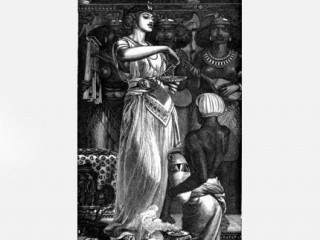
Queen Cleopatra VII biography
Date of birth : -
Date of death : -
Birthplace : Alexandria, Egypt
Nationality : Egyptian
Category : Historian personalities
Last modified : 2010-10-01
Credited as : Queen of Egypt, Julius Caesar,
52 votes so far
Third daughter of Ptolemy XII Auletes, Cleopatra VII Philopator (her full name) learned her political lessons by watching the humiliating efforts of her father to maintain himself on the throne of Egypt by buying the support of powerful Romans. When he died in 51 B.C., the ministers of Cleopatra's brother Ptolemy XIII feared her ambition to rule alone and drove her from Egypt in 48.
Cleopatra and Julius Caesar
Cleopatra made preparations to return by force, but when Caesar arrived in Alexandria after the Battle of Pharsalus, she saw the opportunity to use him. She had herself smuggled to him in a rug. Ptolemy XIII died fighting Caesar, who restored Cleopatra to the throne with another brother, Ptolemy XIV, as coregent.
Contrary to legend, Caesar did not dally in Egypt with Cleopatra. Although in 46 she gave birth to a son whom she named Ptolemy Caesarion, Caesar never formally recognized him. That same year Caesar invited her to Rome. Although he spent little time with her, her presence in Rome may have contributed to the resentment against him which led to his assassination.
In April 44 B.C. Cleopatra returned to Alexandria, where Ptolemy XIV had died under mysterious circumstances. She made Caesarion her partner on the throne and awaited the outcome of the political struggle in Rome. When, after the Battle of Philippi, Antony summoned her and other puppet rulers to Tarsus in Cilicia, she responded eagerly. Matching her preparations to the man whose weaknesses she knew, she dazzled Antony and bent him to her will. She easily cleared herself of a charge of helping Brutus and Cassius, and at her request Antony put to death three persons she considered a threat to her throne.
Cleopatra and Mark Antony
In the winter of 41/40 Antony followed Cleopatra to Alexandria, where he reveled in the pleasures of the Ptolemaic court and the company of the Queen. Cleopatra hoped to tie him emotionally to her, but Antony left Egypt in the spring of 40.
In the autumn of 37 Antony sent his wife, Octavia, back to Italy on the excuse that she was pregnant and went to Antioch to make final preparations for his invasion of Parthia. In Antioch he again sent for Cleopatra and went through a ritualistic marriage not recognized under Roman law. He also recognized the twins Cleopatra had with him and made extensive grants of territory to her, including Cyprus, Cyrene, and the coast of Lebanon, all of which had once been part of the Ptolemaic empire.
In 36 Cleopatra returned to Alexandria to await the birth of her third child by him. The failure of the Parthian campaign and Octavian's exploitation of Antony's misadventure drove Antony further into the arms of Cleopatra, who gave him immense financial help in rebuilding his shattered army. When Antony defeated Artavasdes of Armenia in 34, he celebrated his triumph not in Rome but in Alexandria. On the following day he declared Cleopatra and Ptolemy Caesarion joint rulers of Egypt and Cyprus and overlords of all lands west and east of the Euphrates. For Cleopatra this meant the potential union of the Ptolemaic and Seleucid empires under her control, and Antony staked out his claims on the wealth of Egypt for the coming struggle with Octavian.
In Italy, Octavian used the donations at Alexandria and Antony's relations with Cleopatra to turn public opinion against him. The Battle of Actium (Sept. 2, 31), fought for the control of the Roman Empire, led to the final disaster. Because Cleopatra's money built the fleet and supported it, she insisted on fighting at sea. When she fled from the battle with the war chest, Antony had little choice but to follow.
After Actium, Cleopatra tried to negotiate with Octavian for the recognition of her children as her successors in Egypt. But as his price Octavian demanded the death of Antony, and Cleopatra refused. After the final battle outside Alexandria on Aug. 1, 30 B.C., in which his troops deserted him, Antony stabbed himself when he received a false report that Cleopatra was already dead. Antony died in Cleopatra's arms inside her mausoleum, where she had barricaded herself with the treasures of the Ptolemies to keep them from Octavian.
Tricked into surrendering herself, Cleopatra tried again to negotiate with Octavian. Rebuffed, she carefully planned her own death. On August 10, after paying last honors to Antony, she retired to her quarters for a final meal. How Cleopatra died is not known, but on her left arm were found two tiny pricks, presumably from the bite of an asp.
















